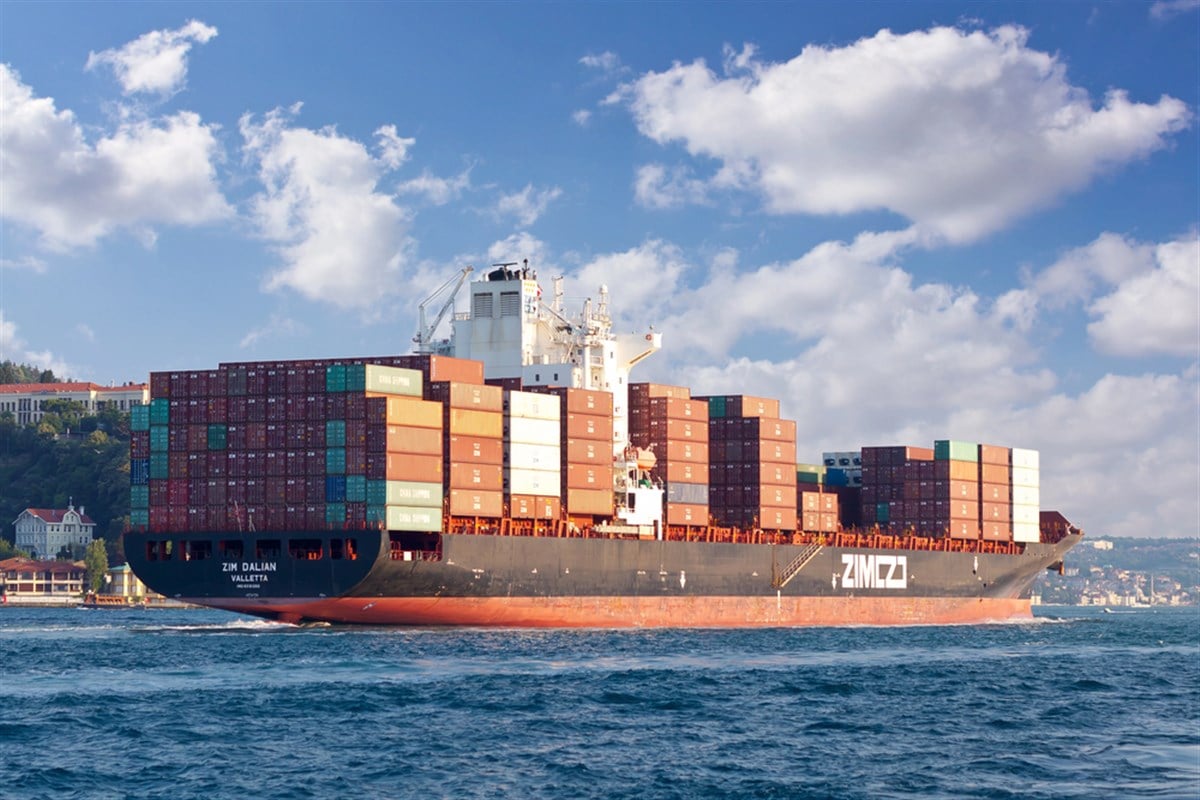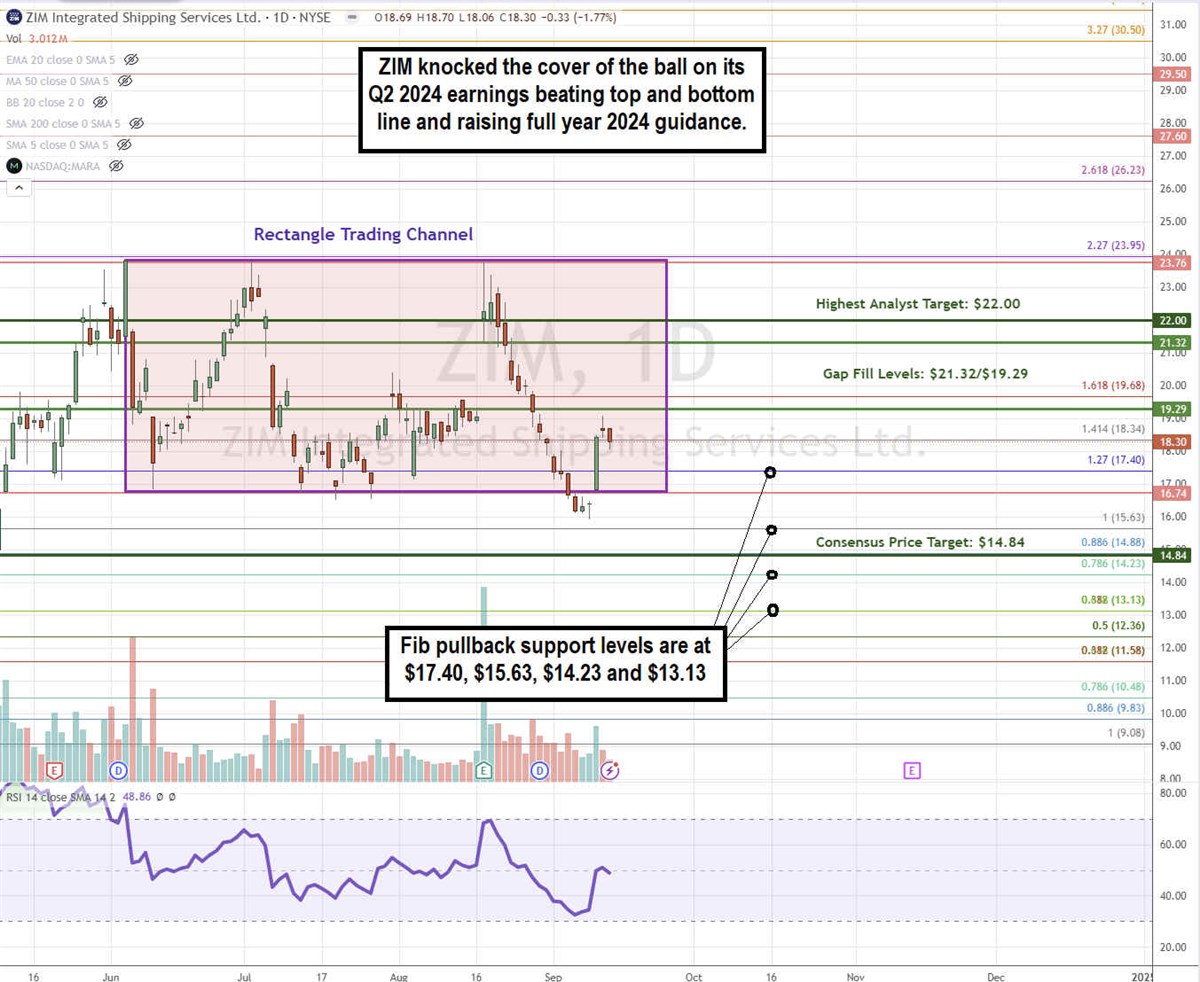Spotlight on ZIM: Take Advantage of Shipping Stock Upside

Global shipping company ZIM Integrated Shipping Services Ltd. (NYSE: ZIM) has seen its business improve across the board since the start of the Red Sea conflict, which began on October 19, 2023. The conflict elevated spot shipping rates, benefiting transportation companies like Genco Shipping & Trading Ltd (NYSE: GNK), Star Bulks Carriers Co. (NASDAQ: SBLK), and Danaos Co. (NYSE: DAC).
What was meant to hurt Israel-based shipping companies like ZIM has inadvertently created a windfall that continues as a tailwind as long as ships avoid the Suez Canal, which accounts for 15% of the world’s shipping cargo volume. ZIM shares staged a strong rally on its second-quarter 2024 earnings report but has since seen shares pull back as much as 33% from the $23.76 triple top.
Shipping Rates May Have Peaked
Despite the challenges posed By the Red Sea conflict, ZIM has demonstrated resilience and adaptability. The company's ability to navigate these turbulent waters is a testament to its strength and strategic foresight. The Shanghai Container Freight Index (SCFI) surged to 3,187 by June 7, 2024, up from 1,757 on April 12, 2024. However, rates have been steadily falling as it closed at 2,511 on September 13, 2024. Normalization may be setting in despite the tense situation in the Red Sea. Potential chances for a ceasefire don't seem likely in the near term.
Another Catalyst for Surging Freight Rates
While further escalation in the Red Sea could lift freight rates again, there is also another situation that could spike rates. The International Longshoremen's Association (ILA) is the largest maritime workers union in North America. The contract between the ILA and the United States Maritime Alliance (USMA) is set to expire on September 30, 2024. Failing a new contract, the ILA is set to go on strike on October 1, 2024.
To date, neither side has even sat down for formal master contract negotiations in since the last one was called off on June 11, 2024. The last strike occurred in 2002, causing West Coast ports to close for 11 days, causing $1 billion a day in losses, which took six months to recover from.
ZIM Knocks the Cover Off the Ball in the Second Quarter of 2024
ZIM Integrated Shipping reported Q2 2024 EPS of $3.25, crushing consensus estimates by $1.45. Revenues also surged 47.6% YoY to $1.93 billion, which beat consensus estimates by $152.57 million. Net income was $373 million, and adjusted EBITDA was $766 million, achieving 40% margins.
Volumes grew 11% YoY to reach a record carrier volume of 952,000 20-foot equivalent units (TEUs). TEU is a metric used as a standard unit of measurement, representing the cargo capacity of the standard 20-foot-long intermodal shipping container. The average freight rate per TEU was $1,674, representing a 40% YoY increase.
ZIM CEO Eli Glickman commented, "During the quarter, we benefitted from ZIM's strategic decision to increase the Company's spot market exposure in the Transpacific trade. This has enabled us to capture a significant upside in a rate environment that has been elevated for longer than anticipated. We expect our results in the second half of 2024 to be better than in the first half of the year, driven by continued supply pressure from the Red Sea crisis, combined with current favorable demand trends.”
ZIM Raises Full Year Guidance
Strong demand trends have propelled ZIM to significantly raise its full-year 2024 guidance. With adjusted EBITDA expected between $2.6 billion and $3 billion and adjusted EBIT between $1.45 billion and $1.85 billion, ZIM is poised for substantial growth. The company also anticipates the delivery of the remaining 8 of 46 modern and fuel-efficient containerships, including 28 liquid natural gas (LNG) powered vessels, which will further enhance its operational efficiency.
ZIM Stock Is in a Rectangle Trading Channel
A rectangle channel is comprised of two trend lines: a flat-top upper trendline resistance and a flat-bottom lower horizontal trendline support.

ZIM formed a triple top and the flat-top upper trendline resistance at $23.76. The flat-bottom lower trendline support is at $16.74. After peaking at the upper trendline resistance at $23.76 on its earning gap, ZIM proceeded to fall through the lower trendline support, bottoming at $15.90 before rebounding hard back into the trading channel at $18.30. The daily relative strength index (RSI) is stalled at the 49-band. Fibonacci (Fib) pullback support levels are at $17.40, $15.63, $14.23, and $13.13.
ZIM Integrated Shipping Services’ average consensus price target is $14.84, and its highest analyst price target sits at $22.00. It has one analyst Buy rating and four analyst Sell ratings.
For bullish options investors, there's an opportunity to limit maximum downside and profit from potential stock price gains with less capital than owning the stock. This can be achieved by implementing a bullish call debit spread, a strategy that offers the potential for significant profit in a rising market.
More News
View More




Recent Quotes
View More
Quotes delayed at least 20 minutes.
By accessing this page, you agree to the Privacy Policy and Terms Of Service.